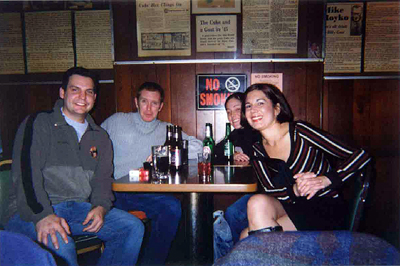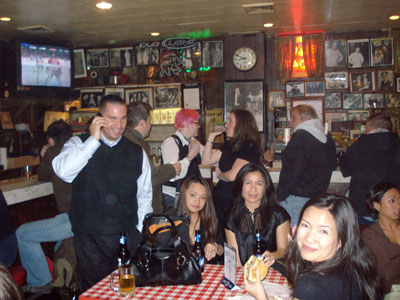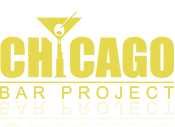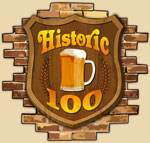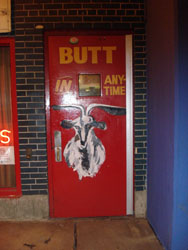
“Butt in anytime”
Billy Goat Tavern Photo Archive
Lower Level Libations
Ever hear of the “Curse of the Billy Goat,” also known as the “Cubs Curse”? Remember reading about Mike Royko’s favorite place in his nationally syndicated column? Or, do you recall the Saturday Night Live sketch in which a short order cook would yell out to incoming patrons: “Cheezborger! Cheezborger! No fries, cheeps! No Pepsi, Coke!”? All of the above have one thing in common: the Billy Goat Tavern. Because of its subterranean location beneath the Chicago Tribune Building, the present location of the Billy Goat has been an underground oasis for journalists and tradesmen seeking a break from sobriety during lunchtime and after work. Many of them became regulars as colorful as the original owner, William “Billy Goat” Sianis, and his nephew and current owner, Sam Sianis. Legions of tourists also descend upon The Goat to get yelled at and to enjoy some of the best burgers in the city. As a result, the Billy Goat Tavern has become a true Chicago classic and required stopping point for both hungry locals and visitors wishing to gain some insight into the City that Works.
The “world famous” Billy Goat Tavern is not easy to find but is well worth it. To do so, look for the white sign on the sidewalk, just north of the Wrigley Building, inviting you to “butt in any time.” The arrows on the sign point downwards because safe passage to The Goat is most easily had by descending the concrete staircase behind it. As you walk down into the depths of the Magnificent Mile, fear not. The Billy Goat Tavern is located at the base of the staircase and just around the corner on your right, beyond a series of dumpsters. This darkened corner–even in the daytime when lit with orange sodium lamps–is actually the intersection of Lower Michigan Avenue and Hubbard Street. Another staircase in front of the internationally renowned Tribune Tower also allows access to the bar, as does Hubbard Street if you walk eastwards from State Street. If you get turned around, just look for the Billy Goat’s ancient wooden sign, ominous brick facade, and neon “Billy Goat” and “Old Style” signs in the small windows with iron bars.
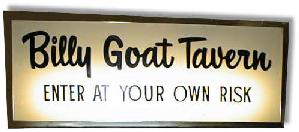
“It was 1:30 a.m., a half-hour to closing time in Billy Goat’s Tavern, which is in a basement on Hubbard Street near the Chicago River. A dozen or so people sat at the bar. Most of them had finished work at midnight, so it was their cocktail hour. But people who finish work at midnight aren’t full of smart cocktail talk. They don’t even drink cocktails, at least not in Billy Goat’s, where the ‘in’ drink is still a shot and a beer.”
– excerpt from Mike Royko’s “Midnight Cocktails with a Twist,” as reprinted in Sez Who? Sez Me (original column ran on March 25, 1974)
Brace Yourself, We’re Going In…
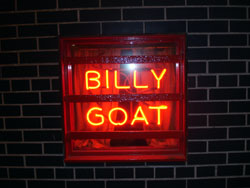 Step into the Billy Goat by pulling open the heavy, red metal door with a picture of a billy goat painted upon it. Inside, you’ll find a set of steps leading down into wood paneled den that essentially has not changed since it opened. Part greasy diner, part drunkard’s refuge, you will first be confronted by a sign reading, “Enter at your own risk,” followed immediately by a Greek short order cook yelling, “Cheezborger! Cheezborger! You want doublecheez?!? Who’s next!?! WHO’S NEXT!?!” If you take more than one second to answer: “Don’t look at the menu, look at ME! I order for you – DOUBLECHEEZ!” If you only feel like a single: “No. DOUBLECHEEZ!!!” If it’s the end of the week: “It’s Friday, doublecheez for everybody! It’s payday! Triplecheez for the big guy!” Want French fries with that? “No fries – CHEEPS!” Thirsty? “No Pepsi – COKE!” To drink: “Coke or Diet?!” Requests for water or Sprite are only accepted begrudgingly. Ordering at The Goat is not for the skittish.
Step into the Billy Goat by pulling open the heavy, red metal door with a picture of a billy goat painted upon it. Inside, you’ll find a set of steps leading down into wood paneled den that essentially has not changed since it opened. Part greasy diner, part drunkard’s refuge, you will first be confronted by a sign reading, “Enter at your own risk,” followed immediately by a Greek short order cook yelling, “Cheezborger! Cheezborger! You want doublecheez?!? Who’s next!?! WHO’S NEXT!?!” If you take more than one second to answer: “Don’t look at the menu, look at ME! I order for you – DOUBLECHEEZ!” If you only feel like a single: “No. DOUBLECHEEZ!!!” If it’s the end of the week: “It’s Friday, doublecheez for everybody! It’s payday! Triplecheez for the big guy!” Want French fries with that? “No fries – CHEEPS!” Thirsty? “No Pepsi – COKE!” To drink: “Coke or Diet?!” Requests for water or Sprite are only accepted begrudgingly. Ordering at The Goat is not for the skittish.
The SNL Connection
 Such rantings by the Billy Goat staff have gone on for almost 40 years and originated when Billy Goat Sianis and another Greek immigrant by the name of Bill Charuchas would entertain patrons by yelling out: “Try the double cheese! It’s the best! No fries, cheeps!” In the 1970s, Sianis and Charuchas were immortalized by Saturday Night Live’s John Belushi, Dan Aykroyd and Bill Murray. The sketch was originally written by Don Novello (of Father Guido Sarducci fame) when he was an advertising copywriter in Chicago. John Belushi and Bill Murray knew the Billy Goat from their Second City days, and the rest is history. As a result, the Billy Goat Tavern achieved national infamy. I don’t know how they do it, but the Billy Goat Tavern still manages to hire thick accented fry cooks who become up-sellers extraordinaire just like the Charuchas that came before them. Bill Charuchas died from a gall bladder infection in his former hometown in Greece on October 31, 2001 after slingin’ burgers at the Goat for almost four decades.
Such rantings by the Billy Goat staff have gone on for almost 40 years and originated when Billy Goat Sianis and another Greek immigrant by the name of Bill Charuchas would entertain patrons by yelling out: “Try the double cheese! It’s the best! No fries, cheeps!” In the 1970s, Sianis and Charuchas were immortalized by Saturday Night Live’s John Belushi, Dan Aykroyd and Bill Murray. The sketch was originally written by Don Novello (of Father Guido Sarducci fame) when he was an advertising copywriter in Chicago. John Belushi and Bill Murray knew the Billy Goat from their Second City days, and the rest is history. As a result, the Billy Goat Tavern achieved national infamy. I don’t know how they do it, but the Billy Goat Tavern still manages to hire thick accented fry cooks who become up-sellers extraordinaire just like the Charuchas that came before them. Bill Charuchas died from a gall bladder infection in his former hometown in Greece on October 31, 2001 after slingin’ burgers at the Goat for almost four decades.
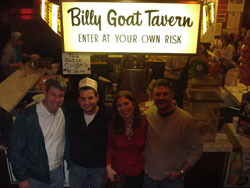 The burgers are great. I recommend the double-cheeseburger, especially as that is probably what you’ll wind up with. Part of their appeal is that they’re served on a Kaiser roll. The other part: the best sandwich pickles in the city. Perhaps this is why, in 1999, Vlassic unveiled the world’s largest pickle at The Goat – its likeness is encased in plastic on the counter, above the plastic donut case and next to the chip racks. When it’s served to you, take the piece of wax paper holding your burger over to the condiment counter and load up with the aforementioned pickles, ketchup, mustard, onions, etc. My advice: take some extra pickles to eat on the side. The Goat also serves up a mean ribeye steak sandwich, also a popular favorite with the regs. Egg & cheese sandwiches (also served on Kaiser rolls), omelets, bacon, and sausage are slung when during the breakfast hours of 7:00am to 11:00am. For those of you keeping score at home, the Billy Goat shuts at 2:00am, leaving the city goat-less for only five hours each night.
The burgers are great. I recommend the double-cheeseburger, especially as that is probably what you’ll wind up with. Part of their appeal is that they’re served on a Kaiser roll. The other part: the best sandwich pickles in the city. Perhaps this is why, in 1999, Vlassic unveiled the world’s largest pickle at The Goat – its likeness is encased in plastic on the counter, above the plastic donut case and next to the chip racks. When it’s served to you, take the piece of wax paper holding your burger over to the condiment counter and load up with the aforementioned pickles, ketchup, mustard, onions, etc. My advice: take some extra pickles to eat on the side. The Goat also serves up a mean ribeye steak sandwich, also a popular favorite with the regs. Egg & cheese sandwiches (also served on Kaiser rolls), omelets, bacon, and sausage are slung when during the breakfast hours of 7:00am to 11:00am. For those of you keeping score at home, the Billy Goat shuts at 2:00am, leaving the city goat-less for only five hours each night.
The Other “L”
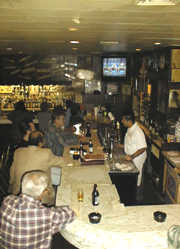 Not eating? Have a drink with the regulars at the wraparound, linoleum-topped, L-shaped bar where well-seasoned booze-wranglers slide bottles along the bar to thirsty tradesmen, journalists and adventurous tourists. Behind the bar, you can also purchase cigarettes and half pints of liquor to take back to work with you. If you feel like taking a piece of the Billy Goat home with you, besides a debilitating bout of heartburn, hats ($5), t-shirts ($10) and sweatshirts ($15) all with the somewhat bizarre, Pan-like image of Billy Goat Sianis’ head upon a goat’s body are all available for sale – “BUY NOW” the sign says. Paper hats in the same style that the cooks wear are available for free if you ask nicely and don’t tie up the line. Billy Goat Dark and Light are on tap, having replaced Schlitz which was served for more than 60 years. Some find it difficult to tell the difference between both Billy Goat concoctions, beyond their color.
Not eating? Have a drink with the regulars at the wraparound, linoleum-topped, L-shaped bar where well-seasoned booze-wranglers slide bottles along the bar to thirsty tradesmen, journalists and adventurous tourists. Behind the bar, you can also purchase cigarettes and half pints of liquor to take back to work with you. If you feel like taking a piece of the Billy Goat home with you, besides a debilitating bout of heartburn, hats ($5), t-shirts ($10) and sweatshirts ($15) all with the somewhat bizarre, Pan-like image of Billy Goat Sianis’ head upon a goat’s body are all available for sale – “BUY NOW” the sign says. Paper hats in the same style that the cooks wear are available for free if you ask nicely and don’t tie up the line. Billy Goat Dark and Light are on tap, having replaced Schlitz which was served for more than 60 years. Some find it difficult to tell the difference between both Billy Goat concoctions, beyond their color.
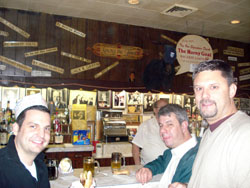 At the bar, one can sit in the “Wise Guy’s Corner,” where a sign says, “If you’re so smart, why ain’t you rich?” If you try to tell the owner what to do, another sign suggests: “BUY ME OUT!” Above the center of the bar, you’ll find an “Among the finest” sign next to the stuffed goat head (we’ll get to that later), famous columnist bylines, photos of Billy Goat Sianis congratulating beauty contestants, and a neon Cubs Old Style sign hangs in the window. On the other end of the bar is a large iron bell in the corner and a Colonel Sanders-like painting of Billy Goat Sianis with a psychedelic background of bright colors that matches those found painted upon the back wall (they still haven’t framed it after having it hang for over 30 years). If you have to go to the bathroom just look for the neon “Billys” sign (for the gents) or “Nannys” sign (for the ladies).
At the bar, one can sit in the “Wise Guy’s Corner,” where a sign says, “If you’re so smart, why ain’t you rich?” If you try to tell the owner what to do, another sign suggests: “BUY ME OUT!” Above the center of the bar, you’ll find an “Among the finest” sign next to the stuffed goat head (we’ll get to that later), famous columnist bylines, photos of Billy Goat Sianis congratulating beauty contestants, and a neon Cubs Old Style sign hangs in the window. On the other end of the bar is a large iron bell in the corner and a Colonel Sanders-like painting of Billy Goat Sianis with a psychedelic background of bright colors that matches those found painted upon the back wall (they still haven’t framed it after having it hang for over 30 years). If you have to go to the bathroom just look for the neon “Billys” sign (for the gents) or “Nannys” sign (for the ladies).
If you’re not bellying up to the bar, have a seat at one of the red & white checkered tables near the bar or on the other side of the grill in the “Wall of Fame” section. This area features photographs of local celebrities and yellowed articles written by famous Chicago newspaper columnists from the nearby Chicago Tribune and Chicago Sun Times like Dave Condon, Roger Ebert, Bill Granger, and Irv Kupcinet. One of the largest “displays” is dedicated to the legendary Pulitzer Prize-winning Trib columnist, Mike Royko, and is comprised of photos, columns, and a memorial written by Royko following the passing of Billy Goat Sianis himself. In it, Royko declares Sianis the “greatest innkeeper in Chicago.”
Slats Grobnik’s Alter Ego
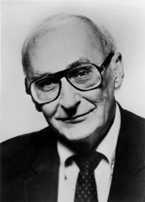 Mike Royko would know. Royko grew up in Wicker Park and, between the ages of 13 and 19, actually bartended at the Blue Sky Lounge (Milwaukee Avenue), Twilight Inn (Armitage Avenue), Hawaiian Paradise (Ashland Avenue), Twilight Inn II (Western Avenue), Cullerton Tap (W. Cullerton Street), and several others. In Mike’s own words, “I was able to obtain this employment despite my youth because I was hardworking, industrious, and my old man owned the joints. Additional duties: accepting bets on horses; preventing customers from falling asleep with head in toilet; admitting regular patrons through side door at 8:00am on Sunday so they could get over shakes and go to church; answering phone and telling wives that husbands had not been there all evening; appraising wristwatches for payment of drinks in lieu of cash; dispensing hard-boiled eggs, pickled pigs feet, beef jerky, and other gourmet delights; breaking up fights by unleashing a Doberman named Death and letting him gnaw on brawlers until peace was restored; and, finally, giving monthly cash-stuffed envelope to police bagman for assorted favors, such as overlooking a thirteen-year-old bartender.” Royko’s additional experience: “Saw a one-legged man dance on a bar in Munich. Got winked at by a one-eyed woman in Marseille. Went into Schaller’s Pump in Mayor Daley’s neighborhood on St. Patrick’s Day and escaped alive. Saw a man win a bet in Milwaukee that he could drink a quart of vodka in five minutes, and helped put him in the ambulance. Saw a man in Wyoming who was arrested for hitting a bartender on the head with a dog. Saw a 130-pound lady bartender named Kitty in Logan Square knock a 210-pound hillbilly unconscious with one punch to his brow. She had a quart jar of Polish pickles in her hand when she punched him,” (excerpt from Mike Royko’s “Soaking up History,” as reprinted in Sez Who? Sez Me; the original column ran on March 29, 1979).
Mike Royko would know. Royko grew up in Wicker Park and, between the ages of 13 and 19, actually bartended at the Blue Sky Lounge (Milwaukee Avenue), Twilight Inn (Armitage Avenue), Hawaiian Paradise (Ashland Avenue), Twilight Inn II (Western Avenue), Cullerton Tap (W. Cullerton Street), and several others. In Mike’s own words, “I was able to obtain this employment despite my youth because I was hardworking, industrious, and my old man owned the joints. Additional duties: accepting bets on horses; preventing customers from falling asleep with head in toilet; admitting regular patrons through side door at 8:00am on Sunday so they could get over shakes and go to church; answering phone and telling wives that husbands had not been there all evening; appraising wristwatches for payment of drinks in lieu of cash; dispensing hard-boiled eggs, pickled pigs feet, beef jerky, and other gourmet delights; breaking up fights by unleashing a Doberman named Death and letting him gnaw on brawlers until peace was restored; and, finally, giving monthly cash-stuffed envelope to police bagman for assorted favors, such as overlooking a thirteen-year-old bartender.” Royko’s additional experience: “Saw a one-legged man dance on a bar in Munich. Got winked at by a one-eyed woman in Marseille. Went into Schaller’s Pump in Mayor Daley’s neighborhood on St. Patrick’s Day and escaped alive. Saw a man win a bet in Milwaukee that he could drink a quart of vodka in five minutes, and helped put him in the ambulance. Saw a man in Wyoming who was arrested for hitting a bartender on the head with a dog. Saw a 130-pound lady bartender named Kitty in Logan Square knock a 210-pound hillbilly unconscious with one punch to his brow. She had a quart jar of Polish pickles in her hand when she punched him,” (excerpt from Mike Royko’s “Soaking up History,” as reprinted in Sez Who? Sez Me; the original column ran on March 29, 1979).
Royko was often found each day after work, holding court down at the Billy Goat in the aforementioned “Wise Guy’s Corner.” He would entertain crowds by espousing local politics as the “voice of the little guy.” On one occasion, after writing some unfavorable things about the local plumber’s union, my friend’s dad (a plumber) confronted Royko and, after receiving an unsatisfactory response from the writer, punched Royko in the face. Royko was not an easy person to talk to, but never hid himself away in an ivory tower. If you wanted to talk to him, you came to The Goat where he would back up what he said to anyone. Mike Royko’s biting satire as well as his everyman character, Slats Grobnik, came to an end on April 29, 1997, when he passed away from a brain aneurysm at the age of 64. For those like me that read his columns, he is dearly missed and can never be replaced. Shortly after he died, the Illinois State House of Representative passed resolution 90_HR0140 honoring Mike Royko as one of Illinois’ “most valuable citizens.” The resolution was presented to his wife, Judy (Arndt) Royko, and his children.
Birth of a Legend
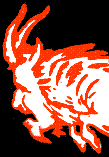 The original Billy Goat Tavern location was “born” in 1934 at 1855 W. Madison (reputed to be run by the Thompson organization in the 1920s), when Greek immigrant, William “Billy Goat” Sianis, purchased the Lincoln Tavern. Billy Goat bought the tavern for $205, with a check that bounced but was later repaid with sales from the first weekend. The tavern was located across from the Chicago Stadium (now United Center) and attracted mainly sports fans. Sianis became known as “Billy Goat,” when a goat fell off a passing truck and wandered inside. Sianis adopted the goat, grew a goatee, acquired the nickname “Billy Goat,” and changed the name of the bar to the Billy Goat Tavern.
The original Billy Goat Tavern location was “born” in 1934 at 1855 W. Madison (reputed to be run by the Thompson organization in the 1920s), when Greek immigrant, William “Billy Goat” Sianis, purchased the Lincoln Tavern. Billy Goat bought the tavern for $205, with a check that bounced but was later repaid with sales from the first weekend. The tavern was located across from the Chicago Stadium (now United Center) and attracted mainly sports fans. Sianis became known as “Billy Goat,” when a goat fell off a passing truck and wandered inside. Sianis adopted the goat, grew a goatee, acquired the nickname “Billy Goat,” and changed the name of the bar to the Billy Goat Tavern.
The Republican Convention came to town in 1944 and Billy Goat posted a sign saying, “No Republicans allowed.” This caused the tavern to be packed with Republicans demanding to be served, and led to local fame for the savvy Billy Goat, publicity stunt master. In 1964, Billy Goat moved his tavern to its present subterranean location. Since then, the Billy Goat Tavern has expanded to include locations on Washington Street (Loop), Wells Street (South Loop), the “Billy Goat Inn” on Madison Avenue (United Center), O’Hare International Airport (now defunct), and at Navy Pier.
“On March 5, 1970, Billy Goat sent letters to then Secretary of State William P. Rogers and Chicago City Collector William T. Prendergast asking for the first food and liquor license on the moon. ‘I believe our astronauts should be entitled to have a nice hamburger and a glass of beer when they arrive from Earth and should not be forced to eat that imitation food,’ wrote Sianis. ‘I intend to take along a couple of goats and will serve a complete line of moonmilk and mooncheese.”
– excerpt from “Cheezborger, Cheezborger, Cheezborger!” by Paul Sullivan in the Chicago Tribune (March 9, 1984),
In the early morning hours of October 22, 1970, Billy Goat Sianis passed away. Mike Royko describes that the night of his death went something like this: “It wasn’t until after three that William (Billy Goat) Sianis, the city’s greatest tavern keeper, would stop talking and allow his nephew, Sam, to help him into his car and drive a few blocks to the St. Clair Hotel, where he lived. Then he went to his room, fell over, and died. It was typical of Billy Goat that he would die during the only five hours of the day when his place wasn’t open for business. That’s how good a businessman he was,” (excerpt from Mike Royko’s “Let’s All Drink to Billy Goat,” column as reprinted in One More Time – The Best of Mike Royko; the original column ran on October 22, 1970). Billy Goat was also described by Jory Graham in her 1967 Chicago, an Extraordinary Guide, in this way: “The proprietor is their [newsmen] friend and round-of-drinks buyer, a twinkling gentleman with a neat white goatee, fine Greek accent and the illusion that he ought to speak like a broken-down newsman, in staccato sentences.”
Curses!
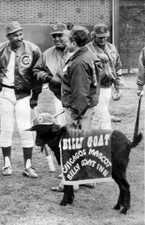 As for the actual billy goat mentioned above, its notoriety does not end with the Billy Goat Tavern. I’m sure we all wish it did. You see, the Chicago Cubs haven’t won a pennant since 1945, and haven’t won a World Series since 1908. Many attribute this misfortune to a hex called the “Curse of the Billy Goat.” In addition to the Cubs being swept in the first round of the 2007 and 2008 playoffs, recent evidence of the curse became evident during Game 6 of the National League Championship Series. Mark Prior and the Cubs were up 3-0 and five outs away from defeating the Marlins, winning the NLCS and moving on to the World Series for the first time in almost 60 years. By trying to catch it himself, a “Cubs fan” by the name of Steve Bartman prevented Cubs left fielder Moises Alou from catching a foul ball that would have been the second out of the eighth inning. Cubs shortstop Alex Gonzalez then uncharacteristically muffed a weakly hit ground ball that could have been the beginning of an inning ending double play. The Marlins went on to score eight runs that inning, take Games 6 and 7, and to win the World Series vs. the Yankees.
As for the actual billy goat mentioned above, its notoriety does not end with the Billy Goat Tavern. I’m sure we all wish it did. You see, the Chicago Cubs haven’t won a pennant since 1945, and haven’t won a World Series since 1908. Many attribute this misfortune to a hex called the “Curse of the Billy Goat.” In addition to the Cubs being swept in the first round of the 2007 and 2008 playoffs, recent evidence of the curse became evident during Game 6 of the National League Championship Series. Mark Prior and the Cubs were up 3-0 and five outs away from defeating the Marlins, winning the NLCS and moving on to the World Series for the first time in almost 60 years. By trying to catch it himself, a “Cubs fan” by the name of Steve Bartman prevented Cubs left fielder Moises Alou from catching a foul ball that would have been the second out of the eighth inning. Cubs shortstop Alex Gonzalez then uncharacteristically muffed a weakly hit ground ball that could have been the beginning of an inning ending double play. The Marlins went on to score eight runs that inning, take Games 6 and 7, and to win the World Series vs. the Yankees.
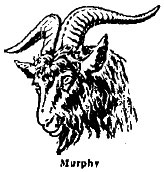 The curse was allegedly placed on the Cubs during the 1945 World Series by Billy Goat Sianis himself. Sianis happened to be a Cubs fan and attempted to bring his goat “Murphy” into Game 4. Murphy even had his own ticket. The pair was let in and Billy Goat paraded Murphy around the visitors dugout but, as soon as owner P.K. Wrigley was told of the goat, P.K. had both Cub fans ejected because of the goat’s smell. In retaliation, Sianis cast a hex over the Cubs by proclaiming: “Cubs, they not gonna win anymore.” The Detroit Tigers went on to win the ’45 Series and the Cubs have never been back. The Cubs’ loss prompted Billy Goat to send a telegram to P.K. Wrigley asking, “Who smells now?” Billy Goat allegedly lifted the curse in 1969 but the Cubs wound up blowing a nine game lead in September that year to the lowly Mets, who went on to win their first World Series.
The curse was allegedly placed on the Cubs during the 1945 World Series by Billy Goat Sianis himself. Sianis happened to be a Cubs fan and attempted to bring his goat “Murphy” into Game 4. Murphy even had his own ticket. The pair was let in and Billy Goat paraded Murphy around the visitors dugout but, as soon as owner P.K. Wrigley was told of the goat, P.K. had both Cub fans ejected because of the goat’s smell. In retaliation, Sianis cast a hex over the Cubs by proclaiming: “Cubs, they not gonna win anymore.” The Detroit Tigers went on to win the ’45 Series and the Cubs have never been back. The Cubs’ loss prompted Billy Goat to send a telegram to P.K. Wrigley asking, “Who smells now?” Billy Goat allegedly lifted the curse in 1969 but the Cubs wound up blowing a nine game lead in September that year to the lowly Mets, who went on to win their first World Series.
Sam I Am
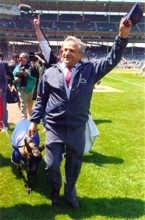 Billy Goat’s nephew, Sam Sianis, now owns the tavern. Sam has not only taken the reigns of running the Billy Goat Tavern, but has also inherited the legacy of the curse. To lift it, Sam twice pulled up to Wrigley Field in 1972 and 1983 in a white limousine with a red carpet, a goat descended from Murphy, and a sign reading: “All is forgiven. Let me lead the Cubs to the pennant. Billy Goat.” Sam was denied entry by Cubs management on both occasions. The curse was then supposedly lifted in 1984, when Cubs management finally relented and Sam brought a goat named “Socrates” to opening day. The Cubs won the division, but ultimately lost to the Padres even though they were up 2-0 in a five game playoff series – the death spiral began for the Cubs after a routine ground ball went through the legs of first baseman Leon Durham. Sam again brought a goat to The Friendly Confines in 1994 after the Cubs lost their first 12 home games. The Cubs won their next game but the season was cut short due to the players’ strike. The goat made its last appearance in 1998, a year that saw the Cubs win a wild card berth in the playoffs but then lose to Greg Maddux (former Cub) and the Braves. Because the Cubs continued to show occasional promise early in the season but always found a way to lose in the end, some suspected that the hex remained in place after 1998. There was even an Old Style television commercial in which the stuffed goat head, mounted above the bar at the Billy Goat Tavern, offers to lift the curse for a sip of a patron’s Old Style. Following the horrific events of 2003, the “Year of the Goat” in the Chinese calendar, many are now convinced that the curse’s hold over the Cubs is as strong as Mayor Daley’s over City Hall.
Billy Goat’s nephew, Sam Sianis, now owns the tavern. Sam has not only taken the reigns of running the Billy Goat Tavern, but has also inherited the legacy of the curse. To lift it, Sam twice pulled up to Wrigley Field in 1972 and 1983 in a white limousine with a red carpet, a goat descended from Murphy, and a sign reading: “All is forgiven. Let me lead the Cubs to the pennant. Billy Goat.” Sam was denied entry by Cubs management on both occasions. The curse was then supposedly lifted in 1984, when Cubs management finally relented and Sam brought a goat named “Socrates” to opening day. The Cubs won the division, but ultimately lost to the Padres even though they were up 2-0 in a five game playoff series – the death spiral began for the Cubs after a routine ground ball went through the legs of first baseman Leon Durham. Sam again brought a goat to The Friendly Confines in 1994 after the Cubs lost their first 12 home games. The Cubs won their next game but the season was cut short due to the players’ strike. The goat made its last appearance in 1998, a year that saw the Cubs win a wild card berth in the playoffs but then lose to Greg Maddux (former Cub) and the Braves. Because the Cubs continued to show occasional promise early in the season but always found a way to lose in the end, some suspected that the hex remained in place after 1998. There was even an Old Style television commercial in which the stuffed goat head, mounted above the bar at the Billy Goat Tavern, offers to lift the curse for a sip of a patron’s Old Style. Following the horrific events of 2003, the “Year of the Goat” in the Chinese calendar, many are now convinced that the curse’s hold over the Cubs is as strong as Mayor Daley’s over City Hall.
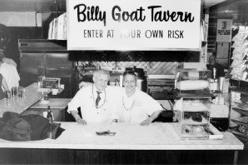 Sam Sianis, now in his sixties, is a character to rival that of his famous uncle. In his younger days, Sam was described by Mike Royko as, “a bull-like young man who was born in Greece, inherited the tavern from his uncle, the original Billy Goat Sianis. He also inherited Billy goat’s strong sense of decency. Billy Goat used to hit male customers with his cane if he saw them staring at female customers in miniskirts,” and, “He [Sam] is only five seven, but he has a nineteen-inch neck and can lift a bar stool by one rung with his teeth,” (excerpts from Mike Royko’s columns Midnight Cocktails with a Twist and Hearty ‘Hallo’ from Greece columns as reprinted in Sez Who? Sez Me; the original column ran on March 25, 1974 and March 23, 1973, respectively). Mike Royko and Sam Sianis fans will appreciate additional columns reprinted in the Sez Who? Sez Me section entitled Boilermakers and Bar Stools, like: The Fluid State of Modern Art, How to Insult a Norwegian, and Sam Bounces to a Record in which Sam is described as having bounced the same patron out of the Billy Goat on five separate occasions, in the same night. Sam became so highly regarded by Royko, that Mike named his third son “Sam” after the innkeeper. In turn, Sam not only wept at news of Royko’s death but also turned the west wall into a Royko shrine. “He was a man of the people, “Sianis said. “He knew about everything.”
Sam Sianis, now in his sixties, is a character to rival that of his famous uncle. In his younger days, Sam was described by Mike Royko as, “a bull-like young man who was born in Greece, inherited the tavern from his uncle, the original Billy Goat Sianis. He also inherited Billy goat’s strong sense of decency. Billy Goat used to hit male customers with his cane if he saw them staring at female customers in miniskirts,” and, “He [Sam] is only five seven, but he has a nineteen-inch neck and can lift a bar stool by one rung with his teeth,” (excerpts from Mike Royko’s columns Midnight Cocktails with a Twist and Hearty ‘Hallo’ from Greece columns as reprinted in Sez Who? Sez Me; the original column ran on March 25, 1974 and March 23, 1973, respectively). Mike Royko and Sam Sianis fans will appreciate additional columns reprinted in the Sez Who? Sez Me section entitled Boilermakers and Bar Stools, like: The Fluid State of Modern Art, How to Insult a Norwegian, and Sam Bounces to a Record in which Sam is described as having bounced the same patron out of the Billy Goat on five separate occasions, in the same night. Sam became so highly regarded by Royko, that Mike named his third son “Sam” after the innkeeper. In turn, Sam not only wept at news of Royko’s death but also turned the west wall into a Royko shrine. “He was a man of the people, “Sianis said. “He knew about everything.”
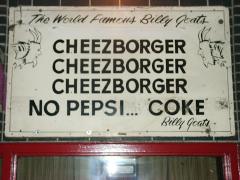
“The Billy Goat is essential for any student of Chicago drinking.”
– Dennis McCarthy, The Great Chicago Bar & Saloon Guide (1985)
The Chicago School
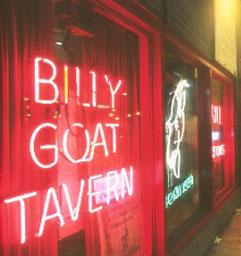 These days, even though the place gets packed with ornery tourists when the tour buses stop by, the Billy Goat Tavern remains a Chicago institution and is as colorful as it lacks natural light. By opening additional locations the Billy Goat joins the likes of Bar Louie, and John Barleycorn’s as bars that have successful enough to warrant multiple locations within the city limits. In recognition of this, the Billy Goat Tavern has won numerous awards for best Chicago tavern, best local tradition and best burger by many such “rating agencies.” The Billy Goat was even frequented by both Al Gore and George W. Bush during the 2000 presidential campaign to prove that they were “regular guys.” Next time you’re in the neighborhood, I recommend that you stop by for a “doublecheezborger,” a Billy Goat Dark and a bit of chat with the regulars. For more information, check out the Billy Goat Tavern website. Chicago Tribune reporter Rick Kogan has also written a great commemoration of the Sianis family and the legendary tavern, in his book: Chicago Tavern: a Goat, a Curse and the American Dream. Just remember: “No fries! CHEEPS!”
These days, even though the place gets packed with ornery tourists when the tour buses stop by, the Billy Goat Tavern remains a Chicago institution and is as colorful as it lacks natural light. By opening additional locations the Billy Goat joins the likes of Bar Louie, and John Barleycorn’s as bars that have successful enough to warrant multiple locations within the city limits. In recognition of this, the Billy Goat Tavern has won numerous awards for best Chicago tavern, best local tradition and best burger by many such “rating agencies.” The Billy Goat was even frequented by both Al Gore and George W. Bush during the 2000 presidential campaign to prove that they were “regular guys.” Next time you’re in the neighborhood, I recommend that you stop by for a “doublecheezborger,” a Billy Goat Dark and a bit of chat with the regulars. For more information, check out the Billy Goat Tavern website. Chicago Tribune reporter Rick Kogan has also written a great commemoration of the Sianis family and the legendary tavern, in his book: Chicago Tavern: a Goat, a Curse and the American Dream. Just remember: “No fries! CHEEPS!”
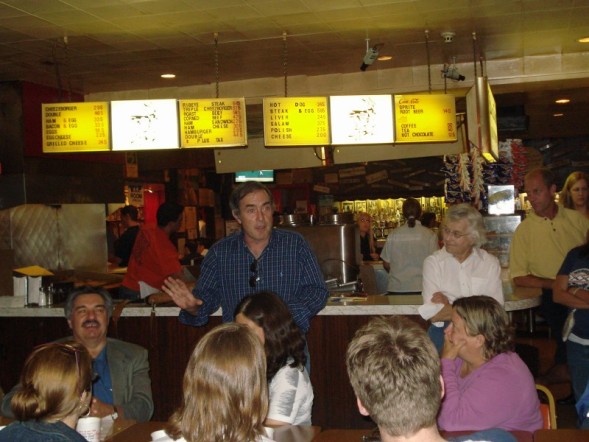
Rick Kogan enthralling the crowd at the Billy Goat Tavern
“Thank you for the great story about the ‘Billy Goat Grill.’ As I was watching the Cubs win a game tonight (a rather important game my baseball fan husband tells me) I saw either a real goat or what could have been a ‘graphic’ goat dash across the screen. Naturally, I was curious as to WHY a goat would dash across the screen. My husband seemed to recollect that there was a ‘goat curse’ associated with the cubs. Naturally then I did a little web research, and came upon your story about the ‘Billy Goat Grill.’ Charming story…and it sure makes me hungry for a ‘cheesborger and some cheeps.”
– GDM (September 10, 2003)
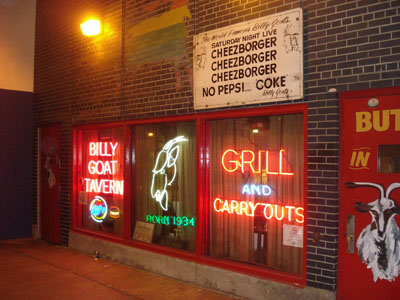
“CHICAGO – The Billy Goat Tavern, a local institution made famous by the ‘Cheezborger, Cheezborger’ sketch on ‘Saturday Night Live,’ is setting up shop in the nation’s capital.
“It’s the first foray outside Chicago for the restaurant, also known for a curse that some say has kept the Cubs out of the World Series for 60 years and counting.
“So, will it work? Sean Parnell, who created a Web site called the Chicago Bar Project, thinks so.
‘One of the attractive things about the Billy Goat … is the atmosphere is very conversational, there’s a long history of getting into political discussions, labor discussions, what’s going on in the city, the Cubs,’ he said. “Washington is a good town for talking about politics, sports, current events.’
– yours truly as featured in Don Babwin’s Associated Press article (September 30, 2005)
“Back in the 80’s I just wondered in to the Billy Goat, not knowing that this was the ‘cheeseburger, cheezeburger’ real deal. I sat at the bar, had a great meal and conversation, and unfortunately, didn’t walk around much and take in all the history. Later in the day, I saw Buddy Rich and His Big Band at the Chicago Jazz Fest in the park, and walked back to check out of my hotel, with great jazz music ringing thru the air in the background. That evening, I was on a flight back to Texas: to this day, it was one of the best days of my life.”
– D.J. (December 27, 2004)
